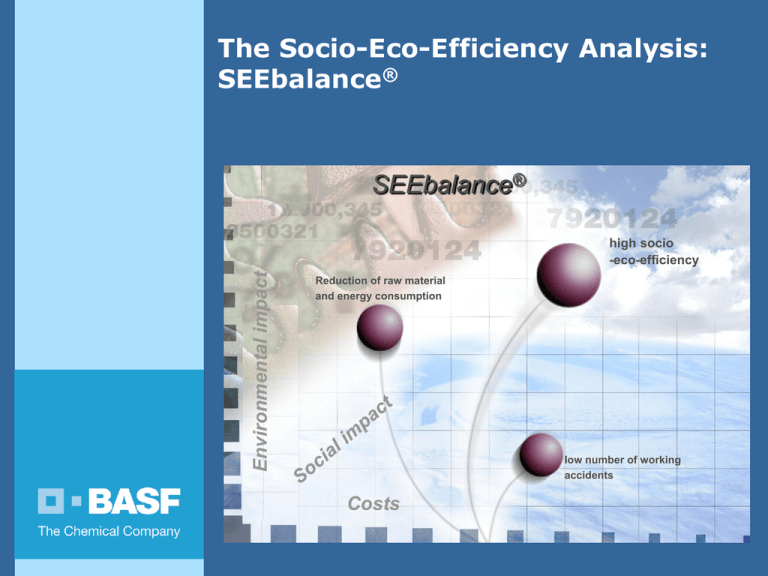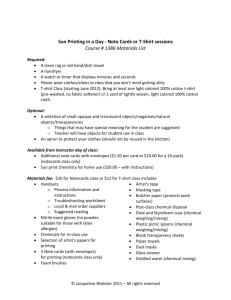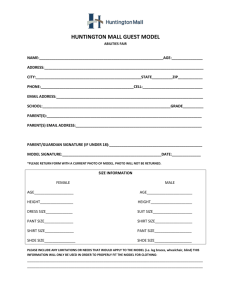Document
advertisement

The Socio-Eco-Efficiency Analysis: SEEbalance® SEEbalance® Environmental impact high socio -eco-efficiency Reduction of raw material and energy consumption low number of working accidents Costs The Four Strategic BASF Guidelines for Long-term Success Help our Earn a customers to be premium on our more successful cost of capital Form the best team in the industry 12.01.2005 Ensure sustainable development 2 The Three Pillars of Sustainable Development Sustainable Development ecology society economy Eco-Efficiency Analysis 12.01.2005 SEEbalance®Analysis 3 Development of SEEbalance® From the Eco-Efficiency Analysis to the SEEbalance® aim: Integration of quantifiable social indicators in the BASF eco-efficiency analysis schedule: starting point 2001 end point March 2005 this subproject was a part of the BMBF project „Sustainable Chemistry of Aromatics“ co-operation partners for the development of the SEEbalance® were: Universität Karlsruhe (TH) Institut für Geographie und Geoökologie 12.01.2005 4 What is an Socio-Eco-Efficiency Analysis (SEEbalance)? Method for the comprehensive assessment of products and processes. Ecological and economic and social aspects are given equal weight in assessments. The products are analyzed from the angle of the end customer. (Future) scenarios and effects of various action options are presented. Eco-efficiency analysis is a standard tool in the BASF Group; more than 240 analyses have been carried out (about 15 SEEbalance). 12.01.2005 5 SEEbalance® Results: Men‘s Shirts User benefit alternative Wearing a blue 100 % cotton shirt men‘s shirt (40 times) Comparable alternatives 100% polyester shirt (PET) blended fabric shirt (65% cotton, 35% PET) This analysis includes in the social assessment the stakeholder employees, consumers, national community and future generations. The 100% polyester shirt is a hypothetical shirt considered only for comparison and is not frequently encountered in the market. 12.01.2005 6 Results: Base Case: Blue Men‘s Shirts envirnonmental burden 0,75 0,75 Wearing a blue men‘s 1,00 shirt (40 1,25 1,25 times) 0,75 1,25 Blended fabric PET 0,75 0,75 1,25 social influence 0,75 Cotton 1,00 costs 1,00 1,00 12.01.2005 1,00 1,00 1,25 1,25 1,00 0,75 costs 7 Weighting Factor Survey in Germany 25% employees 15% working accidents 20% fatal working accidents 15% 20% consumer 20% local & national community 20% future generation 15% international community 12.01.2005 occupational diseases 25% toxicity potential + transport 10% wages and salaries 10% professional training 5% strikes and lockouts 60% toxicity potential 40% other risks and product characteristics 30% employees 15% qualified employees 15% gender equality 10% integration of disabled people 25% number of trainees 25% R&D (company expenditures) 25% capital investments 25% social security 15% parttime employees 15% family support 50% child labour 25% foreign direct investment 25% imports from developing countries 8 Analogies between Ecological and Social LCA Ecological LCA Social LCA What is to be assessed? Potential impact of product or processes on natural capital e. g. - energy consumption - global warming potential (GWP) Potential impact of product or processes on human/social capital e. g. - consumer - future generation 1st : Inventory analysis (inputs/ outputs) 2nd: Impact assessment for defined indicators e. g. GWP: 11 CO2-equivalent per UB 1st : Inventory analysis (inputs/ outputs) 2nd: Impact assessment for defined indicators e. g. employees: 3 working accidents per UB Aggregation and presentation of results UB = user benefit Ökologischer Fingerprint Ecological Fingerprint Social Fingerprint Employees Energy consumption 1,0 1,0 Area use 0,5 Emissions 0,0 Raw material consumption 12.01.2005 alternative 1 alternative 2 Internationale community Consumer 0,0 Future generation Eco-toxicity potential 0,5 Local & national community 9 Results: Social Fingerprint The social fingerprint shows the social influence of a product or process according to the weighting factors employees 1,00 0,50 future generation consumer 0,00 national community cotton 12.01.2005 polyester blended febric 10 Results: Employees: Working Accidents The graph shows that the cotton shirt manufacture causes about four times more working accidents than the polyester shirt manufacture. working accidents / 1 million CB 45 40 35 30 25 The accidents occur primarily during cotton cultivation, since this step is very labour – intensive. 20 15 10 5 0 polyester shirt yarning und weaving cotton shirt blended fabric Many accidents are caused by the use of pesticides. material manufacture transportation energy and water supply cultivation cotton confection upgrading 12.01.2005 11 Assessment Scheme for Social Criteria Normalization factor Weighting factor • Question: To which extent does the product contribute to the social problem on a national level? • Question: How serious is the social problem compared to the others? (probability, extent and duration of consequences) • Character: objective • Source: To be calculated from national statistics X • Character: normative, subjective • Source: polls (among experts or stakeholders) = total assessment factor Source: Schmidt 12.01.2005 12 Course of Action The SEEbalance® will be used as an official tool for life cycle assessment in the eco-efficiency group Boosted external communication and public relations In the future 10 – 20 % of all studies will be SEEbalances® 12.01.2005 13 How Does SEEbalance ® Work? 1st step: Search for the economic sector of the product e.g. polyester: sector “production of polymers” (NACE 24.16) 2nd step: Search for the entries in the social LCA database e.g. Production of polymers (NACE 24.16): – Working accidents: 0.058 accidents / 1000 t – Number of employees: 9,9 employees / 1000 t – ... (all other indicators) „Social profile“ of 1000 t of polyester (analogous to eco-profile) 3rd step: Multiply specific social profile with the product quantities 12.01.2005 14 NACE - International Compatibility Worldwide (UN) EU-Level National Level Industries Goods ISIC CPC NACE CPA national version NACE (e.g. WZ) national version CPA (e.g. GP) Related classifications in more than 140 countries Limited compatibility with NAICS (Canada, USA, Mexico) Source: Eurostat 2003 12.01.2005 15 NACE - The EU-Classification of Industries Sectors Industries A, B Agriculture and forestry, fishing C, D, E Manufacturing industry F Construction G, H, I Commerce, hotel trade, transports J, K Financial industry, enterprise services L-Q Public and private services 12.01.2005 16 NACE – Hierarchical Levels Level Code Example “1-letter” A-Q D Manufacturing industry “2-letters” CA-DN DG Chemical industry “2-digit” 01-99 24 Chemical industry “3-digit” 01.1-99.0 24.1 Production of basic chemical goods “4-digit” 01.11-99.00 24.16 Production of polymers 12.01.2005 17 Life Cycle of the Cotton Shirt production mining of raw materials fertilzer/ pesticides use sum of all transports disposal raw materials MSWI cultivation of cotton and transports yarning weaving production of chemicals for textiles agents retail confection upgrading cleaning/ 40 times ironing collection of old clothing dyeing wearing of the shirt production in China 12.01.2005 Not included because the impact for all alternatives are equal 18 SEECube® 0,75 1,00 0,75 1,25 1,00 1,00 0,75 alternative 1 12.01.2005 1,25 alternative 2 19 Placement of the SEEbalance® „cradle-to-gate“ ...from raw material to factory gate „cradle-to-grave“ ... including use and recycling eco-profile „cradle-to-grave and costs“ ... including all life cycle costs „cradle-to-grave, costs and social aspects“ LCA eco-efficiency ... including social aspects SEEbalance® 12.01.2005 20 Aims of the SEEbalance® 1. „Quality-of-life“: Improvement of objective living conditions Improvement of subjective well-being 2. „Social Cohesion“: Reduction of disparity and social exclusion Fortification of social bonds and coherence 3. „Sustainability“: Intergenerational fairness International responsibility (intergenerational fairness) According to the system of GESIS/ ZUMA 2001 12.01.2005 21 Reasons for the development of the SEEbalance® Integration of the third pillar of sustainability Increasing pressure on part of society Acceptance by the customer is imperative for the purchase of a product Due to the child labour in NIKE sneaker production, a compaign which proclaimed an Anti – Nike day was started (May 2001). Supposed hormonal effects of phthalates (plasticizer) in children’s toys resulted in disappearance from the market even though no scientitic proof existed Taste of packaged food, e.g. sausages TV – enclosure with flame retardant 12.01.2005 22 Application of the SEEbalance® Internal Strategy Comparison of production sites Comparison of markets Marketing (social) acceptance of the product (projects: sausage -study, redevelopment of residential area) Profit: • secure decisions about products and markets • communication - on coperate level - on product level has an established and quantifiable basis (e.g. for coperate reports) External 12.01.2005 23 Procedure define customer benefit society identify products / processes ecology establish life cycle economy determination of social profiles for each step determination of ecoprofiles for each step determination of costs for all life cycle segments aggregation of stakeholder effects aggregation of the effects categories calculation of total life cycle costs normalization of social effects normalization of environmental impact normalization of costs create SEECube® 12.01.2005 24





